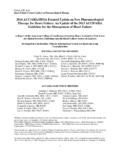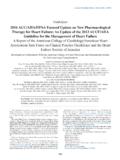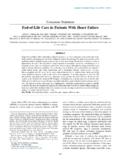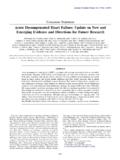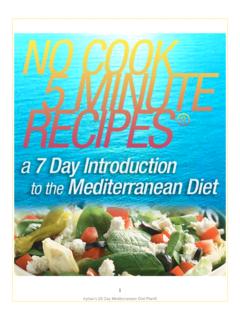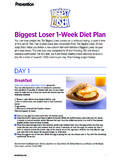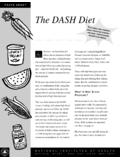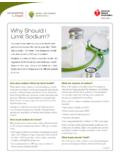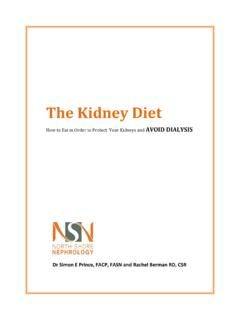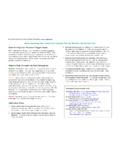Transcription of How to Follow a Low-Sodium Diet
1 Module 2. How to Follow a Low-Sodium diet Contents Introduction 3. What is a Low-Sodium diet ? 4. Chapter 1: How Do I Follow a Low-Sodium diet ? 5. Chapter 2: Reading a Food Label for sodium Content 11. Chapter 3: Tracking the sodium in Your diet 13. Chapter 4: Questions to Ask Your Doctor or Nurse 16. Chapter 5: Questions and Answers About a Low-Sodium diet 20. Learn More 25. Notes 26. Important Information 27. About the HFSA back cover 2013 HFSA, Inc. The information in this booklet is the copyrighted work of The Heart Failure Society of America and/or its affiliates and is protected under US and worldwide copyright laws and treaty provisions. This booklet was developed under the direction of the Heart Failure Society of America. The booklet is designed as an aid to patients/physicians and sets forth current information and opinions on the subject of heart failure.
2 The information in this booklet does not dictate an exclusive regimen of treatments or procedures to be followed and should not be construed as excluding other acceptable methods of practice. Variations taking into account the needs of the individual patient, resources, and limitations unique to the institution or type of practice may be appropriate. 2 Introduction Note that while this module concentrates on following a Low-Sodium diet , other nutritional issues may be of concern to you as well. For example, everyone should watch the amount of fat they eat. Also, if you have diabetes, you should watch the amount of sugar you eat. These issues are discussed in more detail in Module 8: Lifestyle Changes. This module provides information on: n How to Follow a Low-Sodium diet . n The sodium content of selected foods and condiments.
3 N Substitutes for high- sodium foods and condiments. It will help you: n Reduce your sodium intake. n Cook meals with Low-Sodium foods. n Make good choices when you eat in a restaurant. This module has a lot of information in it. You don't have to read come back whenever you have questions about a Low-Sodium diet . 3. What is a Low-Sodium diet ? A Low-Sodium diet includes no more than 2,000 to 3,000. milligrams (mg) of sodium per day. That is the same as 2 to 3. grams of sodium a day. To give you an idea of how much that is, 1 teaspoon of salt = approximately 2,300 mg sodium . People with mild heart failure (no or mild symptoms with vigorous or moderate exercise) are usually asked to limit their sodium intake to 3,000 mg per day. People with moderate to severe heart failure (symptoms with light exercise, household chores or at rest) are usually asked to limit their sodium intake to 2,000 mg per day.
4 Check with your health care provider on the sodium limit that is best for you. Cutting Back on Salt If you need to limit the amount of salt and sodium in your diet , here are some suggestions from the National Heart, Lung and Blood Institute: n Read the food labels to help you pick foods lower in sodium . n Pay attention to the serving size listed on the label. If you eat two cups of a food, but the serving size is one cup, you'll need to double the amount of sodium listed. n Look for foods that use one of these terms on the label: sodium -free, very low sodium , low sodium , reduced sodium , light in sodium or unsalted. Measurement Key Ounce = oz. Milligram = mg Tablespoon = tbsp. Teaspoon = tsp. 4 Chapter 1. How Do I Follow a Low-Sodium diet ? You can take four basic steps to reduce the amount of sodium in your diet : 1.
5 Stop adding salt to your food. 2. Adapt your preferred foods to Low-Sodium versions. 3. Pick foods naturally low in sodium . 4. Learn to read food labels. Step 1: Stop Adding Salt to Food To accomplish this step, try the following tips: n n Do not add salt when cooking. You can reduce your sodium intake by as much as 30 percent bland without salt. You can make foods taste good without salt by trying the following tips: n Experiment with low- or no-salt herbs, spices, and seasoning mixes. n Try using seasonings like black, cayenne, or lemon pepper. Dried and fresh herbs such as garlic, garlic or onion powder (not salt), dill, parsley, and rosemary are also naturally very low in sodium . Combination spice mixes in a bottle are great as long as sodium or salt is not one of the ingredients.
6 N Sprinkle fresh lemon juice over vegetables and salads. Season or n Avoid spices and seasoning mixes with the word salt or sodium in the name. They will be high in sodium . For example, just a teaspoon of a seasoned salt such as garlic salt or celery salt contains about 1,500 mg of sodium . The chart here lists high- sodium seasonings. 5. It can be fun learning new ways to eat. The chart here lists low- sodium seasonings to use when cooking. There are many salt- free seasoning mixes in your supermarket. Look in the spice section for seasonings labeled salt-free . Examples of Low-Sodium spices, herbs, and seasonings Allspice Dry mustard Paprika Basil Flavored extracts Parsley Bay leaves (vanilla, almond, Pimento Black pepper etc.) Red pepper Cayenne pepper Fresh garlic Sage Celery powder Garlic powder Salt substitute Chili powder Ginger (with physician's Chives Lemon juice approval).
7 Cinnamon Low-Sodium ketchup Tabasco pepper sauce Cloves (limit 1-2 tbsp.) (1 tbsp.). Cocoa powder Mrs. DASH Thyme Cumin Nutmeg Vinegar Curry Onion powder Dill Oregano Examples of high- sodium spices, seasonings and condiments Adobo Kosher salt Sazon Alfredo mixes Lite salt Sea salt Barbecue sauce Lite soy sauce Seasoned salt Celery salt Meat tenderizer Soy sauce Cocktail sauce MSG (monosodium Steak sauces Dry meat marinade glutamate) Stir-fry mixes mixes Onion salt Stir-fry sauce Dry salad dressing Pickle relish Taco sauce mixes Plum sauce Taco seasoning Fish sauce Poultry seasoning Teriyaki sauce Garlic salt Regular ketchup Worcestershire sauce Generic sauce mixes Salt Horseradish Salt sense 6 Step 2: Adapt Your Preferred Foods to Low-Sodium Versions To do this, try these tips: n low-salt cookbooks at your local library.
8 You can also buy one at a bookstore or on the Internet. After getting used to Low-Sodium eating, you will be able to adapt your favorite recipes to Low-Sodium versions. For example, if you like soup, make your own Low-Sodium version with fresh meat and vegetables. Toss the ingredients into a slow cooker, and use herbs and spices for seasonings. Make extra and freeze some for later meals. n Use Low-Sodium substitutes for foods that you like. For example, prepare a fresh, lean pork roast instead of a country ham. You can cook fresh chicken, turkey, roast beef, or pork without adding salt and use the meats for sandwiches instead of packaged The chart on page 14 lists a variety of Low-Sodium alternatives for high- sodium foods. n Look for Low-Sodium versions of the foods you like.
9 Many types of canned goods are now available in Low-Sodium versions. Look for canned foods labeled sodium -free, no- salt, Low-Sodium , light in sodium , very Low-Sodium , reduced- sodium , less- sodium , or unsalted. You can also remove some sodium from canned foods by rinsing them. Keep in mind that this does not remove all of the sodium . n Select Low-Sodium cheeses or yogurt when making sauces. 7. These tips can help you ease up on salt: n Look at the labels. sodium levels often vary widely by brand, so compare labels for the healthier option. Try to find foods where each serving size has no more than 5 percent of your recommended daily sodium . n Choose fresh or frozen. These products are naturally low in sodium . Cut back on processed foods, which often have higher amounts of salt.
10 N Adjust your taste buds gradually. When dining out, request that your meal be served with no salt or less salt. At home, experiment with spices, herbs, garlic, and lemon juice instead of salt. Step 3: Pick Foods Naturally Low in sodium To accomplish this step, try the following tips: n Choose fresh foods. Fresh fruits and vegetables including freshly squeezed fruit and vegetable juices have very little Generally, you can eat as much fresh food as you want without counting the sodium content. So, think fresh when choosing foods. n If you are not eating fresh foods, choose other Low-Sodium foods as much as possible. Other good options include canned fruits and plain frozen vegetables. Dried beans, peas, rice, and lentils are also excellent Low-Sodium foods, but make sure not to add salt or other ingredients such as salt pork when cooking them.
